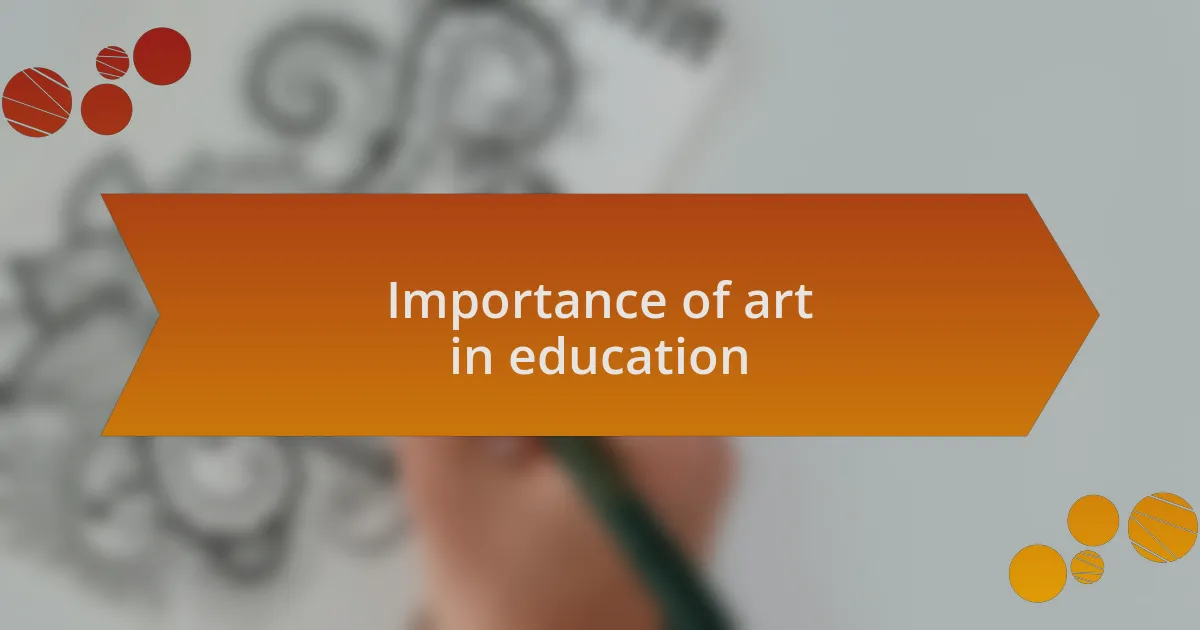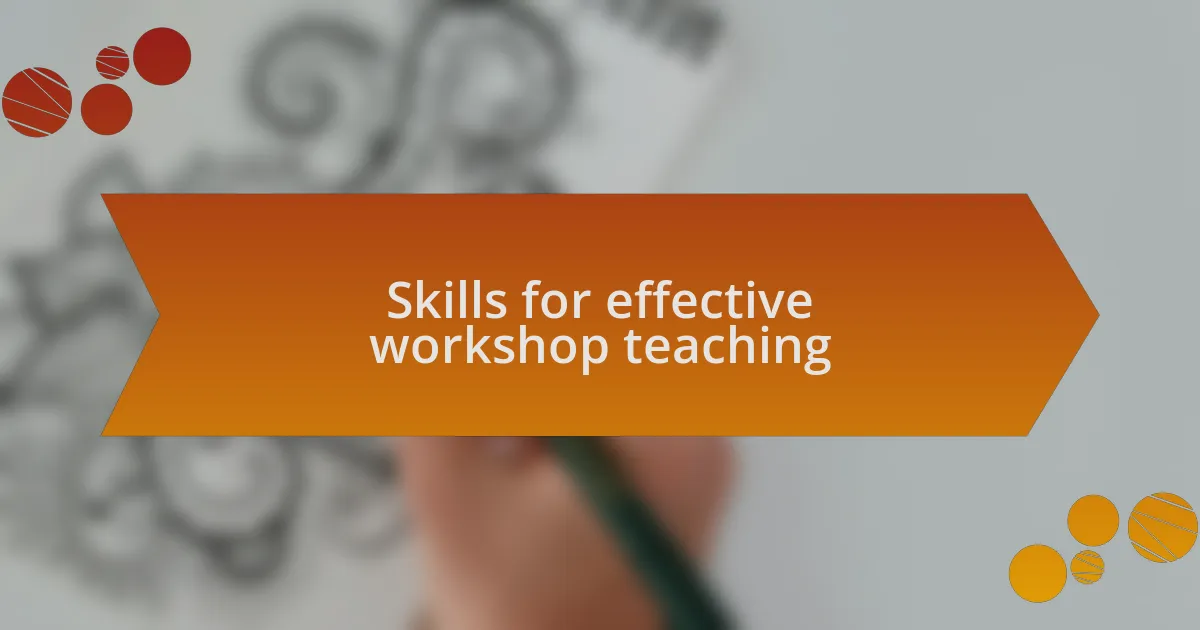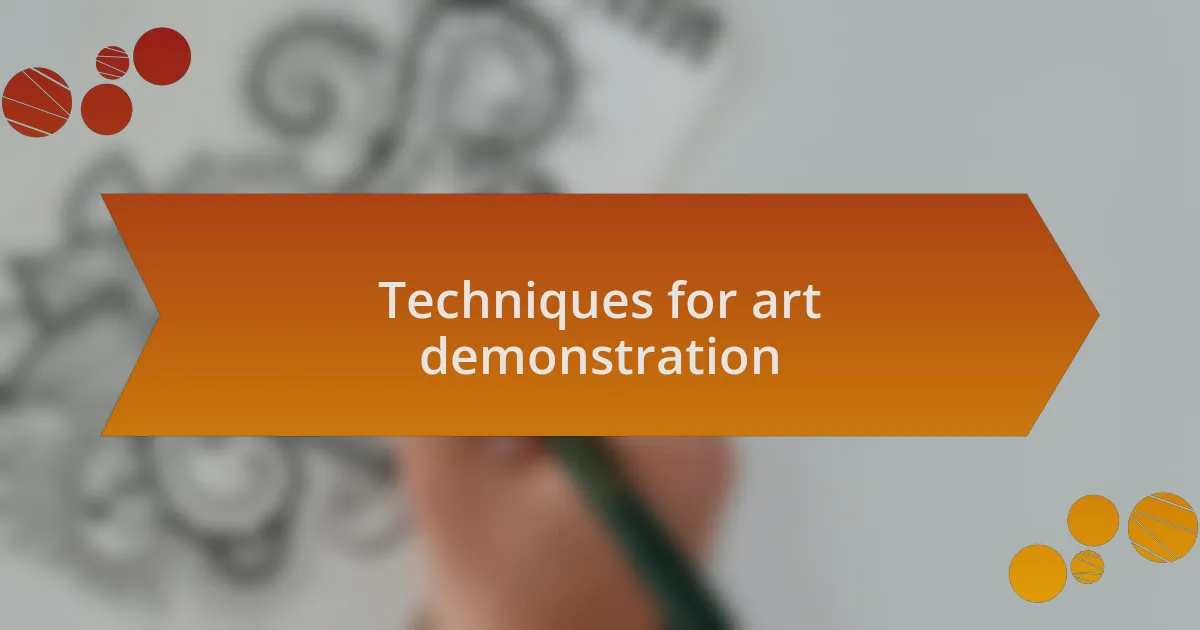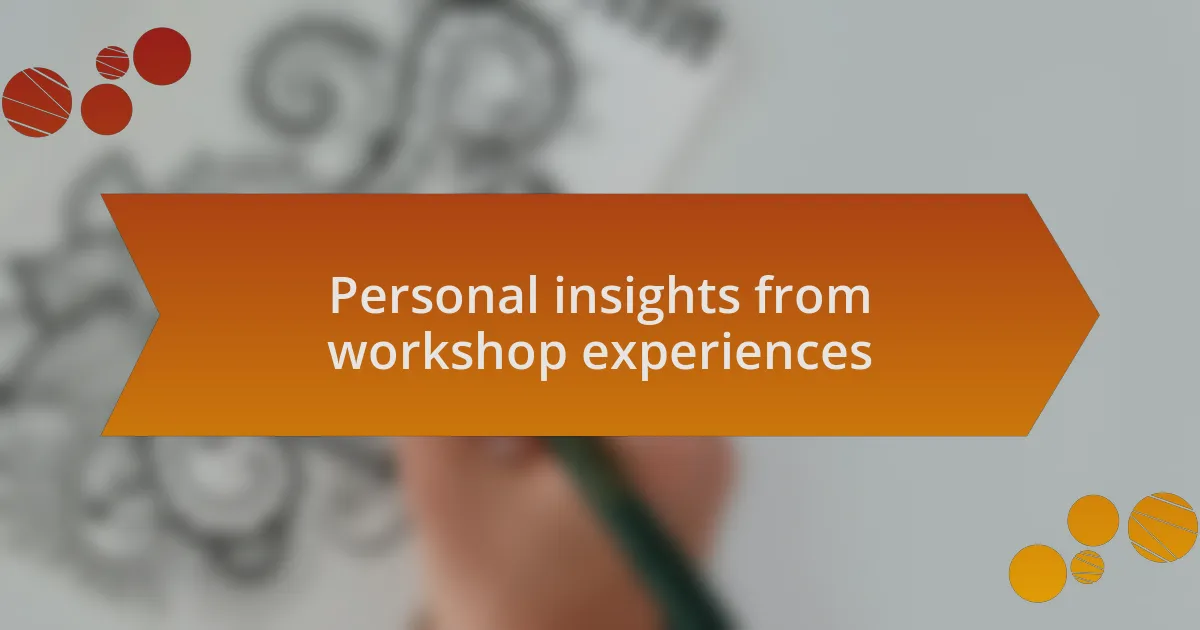Key takeaways:
- Teaching workshops foster a collaborative and dynamic space for creativity, benefiting both instructors and participants.
- Art education enhances personal expression, critical thinking, and community among students.
- Effective workshop teaching requires engagement techniques such as adaptability, clear communication, and hands-on activities.
- Feedback and clear intentions are vital in improving future workshops and maintaining participant connection.

Understanding teaching workshops
Teaching workshops serve as a dynamic platform for both educators and participants to explore art in a hands-on, interactive way. I remember my first experience leading a workshop; the energy in the room was palpable. It sparked a realization that teaching isn’t just about sharing knowledge; it’s about creating a space where creativity can thrive and flourish.
Through my experiences, I came to understand that teaching workshops often reveal unexpected lessons—not just for students, but for instructors as well. For example, during a recent workshop, I unexpectedly found myself learning from my students’ unique perspectives and interpretations of art. Isn’t it fascinating how sometimes the roles reverse, and we become the learners in a teaching environment?
The beauty of these workshops lies in their collaborative nature. When I see participants exchanging ideas and challenging each other’s viewpoints, I can’t help but wonder: what if we all embraced this kind of dialogue in our daily lives? Such moments remind me that teaching is not a one-way street; rather, it’s a shared journey where every voice adds depth to the conversation.

Importance of art in education
Art in education serves as a powerful tool for personal expression and emotional development. I often recall students sharing how creating art allowed them to articulate emotions they found difficult to express with words. Have you ever noticed how a simple painting can convey deep feelings? It’s a reminder of the profound connections art facilitates in our lives.
Integrating art into the curriculum sparks critical thinking and enhances problem-solving skills. When I guided students through a project involving mixed media, I witnessed firsthand how they tackled challenges creatively. Each hurdle became a chance for innovative thinking; it made me realize how art encourages us to view problems from multiple angles. Isn’t it remarkable how a brushstroke can influence one’s approach to real-world issues?
Moreover, art fosters a sense of community among students. In a workshop I conducted, participants collaborated on a mural, and I watched as walls of intimidation came down. As friendships blossomed and teamwork flourished, I wondered: how often do we let our guard down when sharing the creative process? This collaboration not only enhanced their artistic skills but also built connections that lasted beyond the classroom.

Skills for effective workshop teaching
Understanding how to engage your participants is crucial for effective workshop teaching. In my experience, creating an inviting atmosphere encourages attendees to share and express themselves openly. I remember a workshop where I introduced a simple icebreaker activity focused on personal art experiences. The moment participants began to tell their stories, the room transformed; the energy became vibrant and collaborative. Have you ever felt how storytelling can break down barriers?
Another key skill is adaptability. I recall a session where my initial plan fell flat because participants were more interested in exploring abstract techniques than the structured project I had devised. Rather than sticking rigidly to my agenda, I pivoted, diving into spontaneous discussions about their artistic choices. This flexibility not only boosted their enthusiasm but also reinforced my belief that allowing the creative flow to guide us can yield remarkable results. Isn’t it fascinating how unplanned moments can lead to deeper learning?
Lastly, effective communication plays a vital role in workshop success. I strive to present instructions clearly and concisely, while also encouraging questions and feedback. During a recent workshop, I encouraged participants to ask questions as they worked on their pieces. Not only did it foster a supportive environment, but it also deepened their understanding of various techniques. Have you ever found that the right questions can unlock a new level of insight?

Engaging participants in art workshops
One effective way to engage participants in art workshops is through hands-on activities that tap into their emotions. I once led a collage-making session where each attendee selected images that resonated with their personal stories. Watching their eyes light up as they connected with the materials was a powerful reminder of how art can serve as a profound outlet for self-expression. Have you noticed how creating can unlock feelings that words sometimes struggle to convey?
Incorporating collaborative projects also significantly enhances engagement. During a mural painting session, I divided participants into small groups, prompting them to brainstorm a theme together. The energy in the room shifted as ideas flowed freely, and I was thrilled to observe how collaboration united the group, turning individual expressions into a collective masterpiece. It made me wonder: how does our desire to create together enrich our artistic journeys?
Furthermore, fostering a sense of ownership within the workshop can lead to deeper participant investment. I remember encouraging attendees to suggest their personal topics for exploration, which transformed our sessions into a learning experience tailored to their interests. This approach not only ignited their passion but also instilled a shared responsibility for the workshop’s direction. Isn’t it incredible how empowering individuals can cultivate a more dynamic and enthusiastic learning environment?

Techniques for art demonstration
Demonstrating art techniques effectively can significantly enhance the learning experience for participants. I recall a watercolor workshop where I started by painting a simple landscape live, allowing everyone to see each brushstroke and color mix in real-time. This approach helped demystify the process, showing students that art is as much about experimentation as it is about precision. Doesn’t seeing the technique in action ignite a spark of inspiration?
Illustrating diverse techniques can often lead to unexpected discoveries. In one class, I introduced a technique using salt on wet watercolor, letting participants see how it created captivating textures. The amazed gasps when they observed the salt absorbing pigment reminded me that experimentation is just as important as the end result. Isn’t it rewarding to witness that “aha” moment when participants realize their own potential?
Incorporating tips and tricks into demonstrations can also empower artists to develop their styles. During an acrylic pouring session, I shared my go-to methods for achieving unique effects, allowing participants to grasp not just the “how” but the “why” behind each technique. I felt a surge of fulfillment when they began to connect those practices to their previous experiences. How exciting is it to think that a simple technique can lead to a lifetime of creativity?

Personal insights from workshop experiences
I’ve come to appreciate that teaching workshops is often as much about personal connection as it is about skill sharing. During one recent workshop, I discovered that when I opened up about my own struggles with self-doubt in art, participants felt more at ease sharing their own insecurities. It’s remarkable how vulnerability can foster a sense of community. Isn’t it interesting how authentic dialogue can transform a room full of strangers into a supportive group of creators?
Another insight I’ve gained is the power of encouraging participants to embrace improvisation. I remember a moment in a mixed media class when one participant decided to deviate from the project, adding an unexpected pop of neon color. Initially unsure, I watched as her choice energized the whole group, pushing everyone to think outside their usual boundaries. How often do we confine ourselves to “how it should be” rather than allowing the art to evolve organically?
Lastly, I’ve learned that the process of teaching can be equally enlightening for the instructor. In a recent workshop, I experimented with a technique I had only previously practiced. Observing the reactions of my students, who were inspired to take risks themselves, was a powerful reminder that learning is a two-way street. Don’t you find it fascinating that even as an art instructor, each session can reveal new perspectives and ignite fresh passion in your own practice?

Tips for improving future workshops
One way to enhance future workshops is to incorporate diverse feedback mechanisms. In a previous workshop, I handed out simple, anonymous feedback forms after each session. The insights were eye-opening: attendees shared specific moments that resonated with them, but they also noted areas for improvement. How often do we overlook direct input from participants when it can lead to transformative changes?
Additionally, I’ve found that setting clear intentions at the beginning of a workshop establishes a focused atmosphere. In one instance, I took an extra five minutes to outline what participants could expect, which significantly shifted their engagement levels. Have you noticed how clarity can spark enthusiasm? It’s as if the room lights up with possibilities when everyone is on the same page.
Lastly, I believe in the power of follow-up. After a workshop, I started sending out a recap email that included resources and highlights. This simple practice not only reinforces the learning experience but also keeps the connection alive. Isn’t it rewarding to see how ongoing support can help attendees continue their creative journey?